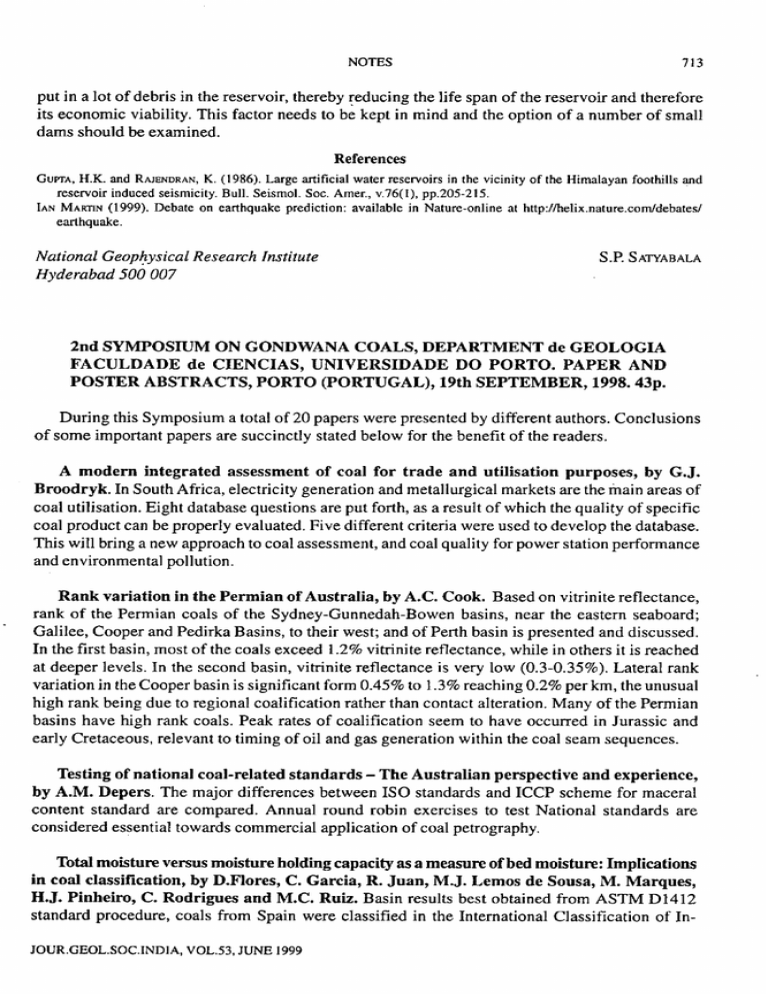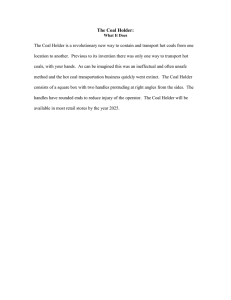put in a lot of debris in the reservoir, thereby reducing the life span of
advertisement

713 NOTES put in a lot of debris in the reservoir, thereby reducing the life span of the reservoir and therefore its economic viability. This factor needs to be kept in mind and the option of a number of small dams should be examined. References GUPTA,H.K. and RAIENDRAN, K. (1986). Large artificial water reservoirs in the vicinity of the Himalayan foothills and reservoir induced seismicity. Bull. Seismol. Soc. Amer., v.76(1), pp.205-225. IANMARTIN (1999), Debate on earthquake prediction: available in Nature-online at http://helix.nature.com/debates/ earthquake. National Geophysical Research Institute Hyderabad 500 007 S.P. SATYABALA 2nd SYMPOSIUM ON GONDWANA COALS, DEPARTMENT de GEOLOGIA FACULDADE de CIENCIAS, UNIVERSIDADE DO PORTO. PAPER AND POSTER ABSTRACTS, PORTO (PORTUGAL), 19th SEPTEMBER, 1998.43~. During this Symposium a total of 20 papers were presented by different authors. Conclusions of some important papers are succinctly stated below for the benefit of the readers. A modern integrated assessment of coal for trade and utilisation purposes, by G.J. Broodryk. In South Africa, electricity generation and metallurgical markets are the main areas of coal utilisation. Eight database questions are put forth, as a resuIt of which the quality of specific coal product can be properly evaluated. Five different criteria were used to develop the database. This will bring a new approach to coal assessment, and coal quality for power station performance and environmental pollution. Rank variation in the Permian of Australia, by A.C. Cook. Based on vitrinite reflectance, rank of the Permian coals of the Sydney-Gunnedah-Bowen basins, near the eastern seaboard; Galilee, Cooper and Pedirka Basins, to their west; and of Perth basin is presented and discussed. In the first basin, most of the coaIs exceed 1.2% vitrinite reflectance, while in others it is reached at deeper levels. In the second basin, vitrinite reflectance is very low (0.3-0.35%).Lateral rank variation in the Cooper basin is significant form 0.45% to I .3%reaching 0.2% per krn, the unusual high rank being due to regional coalification rather than contact alteration. Many of the Permian basins have high rank coals. Peak rates of coalification seem to have occurred in Jurassic and early Cretaceous, relevant to timing of oil and gas generation within the coal seam sequences. Testing of national coal-related standards - The Australian perspective and experience, by A.M. Depers. The major differences between I S 0 standards and ICCP scheme for maceral content standard are compared. Annual round robin exercises to test National standards are considered essential towards commercial application of coal petrography. Total moisture versus moisture holding capacity as a measure of bed moisture: Implications in coal classification, by D.Flores, C. Garcia, R. Juan, M J . Lemos de Sousa, M. Marques, H.J. Pinheiro, C. Rodrigues and M.C. Ruiz. Basin results best obtained from ASTM Dl412 standard procedure, coals from Spain were classified in the International Classification of InJOUR.GEOL.SOC.INDIA, VOL.53,JUNE 1999 seam Coals (1995) as sub-bituminous from Mequinenza and Teruel, and ortho-bituminousfrom Morupule. Application of electron microprobe technique in determining elemental composition of Australian coal macerals, by L.W. Gurba and C.R. Ward. Electron microprobe analysis on a series of high volatile bituminous coals, using same polished sections as for petrological studies,have evaluated that vitrinite has carbon, oxygen and organic sulphur percentages different from inertinite and liptinite. In telocollinite, carbon is 77-86%,reaching 89%in heat-affected coals. Semi fusinite a'nd sporinite show 82-90% and 83-89%, respectively, over the same rank range. Organic sulphur is the lowest in inertinite, highest in liptinite and intermediate in vitrinite. The maceral composition has, therefore, to be considered in interpreting chemical properties of such coals on whole-coal ultimate analysis. Reflectance and fluorescence are also affected by marine influence. Australian cod petrography, by L.W. Gurba and H. Read. The Australian Standard for Coal Maceral Analysis (AS 2856.2- 1998) departs from the ICCP description for some macerals and is tabulated. CLASSIFICATION OF COAL MACERALS Australian Standard AS 2856.2-1998 Coal Petrography Part 2: Maceral analysis Maceral group Maceral subgroup Telovitrinite Vitrinite Textinite # Texto-ulminite # Eu-ulminite # Telocollinite Detrovitrinite Attrinite # Densinite # Desmocollinite Gelovitrinite Cotpogelinite Porigelinite Eugelinite Sporinite Cutinite Resinite Liptodetrinite Alginite Suberinite Fluorinite Exsudinite Bituminite Liptinite Inertinlte MaceraI Telo-inertinite Fusinite Semi fusinite Funginite Detro-inertinite Inertodetnnite Micrinite Gelo-inertinite Secretinite Macrinite # These macerals commonly or only'occur in lower rank coals. JOUR.GEOL.SOC.INDIA, VOL.53, JUNE 1999 NOTES 715 A comparative study on the geology, petrology and palynology of Permian coals in southern Brazil and Tanzania implications for coal formation, by W. Kalkreuth, M. Holz, M. Cazzulo-Klepzig, M. Marques-Toigo, J. Utting and P. Semkiwa. Geological setting, petrology and palynology are described. In Tanzania, the coal petrographic parameters and the diversity of palynomorph suggest peat accumulation in an upper delta plainlbraided plain depositional environments consistent with sedirnentological evidence. In Parana basin, Brazil, open water (limnic), limno-telmatic, telmatic and terrestrial coal-forming mire types and more recently a coastaI swamp environment in a back-barrierhand plain setting are suggested. - Reactive Inertinite in South African coals, by K. Kruszewska. Reactive inertinite or semi fusinite is common in these coals. High amounts of total inertinite (80%) comprised 36% of reactive inertinite.A close relationship existed between the two, and inversely proportional between reactive inertinite and vitrinite. A simplified way to calculate reactive inertinite from total inertinite is suggested. International classification of In-seam coals, by M.J. Lemos de ~ o u s and a H.J. Pinheiro. Economic Commission for Europe (United Nations) system for characterization of coal deposits, and calculation of coal resources and reserves, at international level is presented. The occurrence of thePortalites genus in south Brazilian Gondwana coals, by M. MarquesToigo and M. Cazzulo-Klepzig.Biological affinity, classification and palaeoecology of this genus are discussed in view of characterization of the peat-forming vegetation. , - Coal combustion technologies environmental implications, by B. Valentim. Differences between Gondwana coals and those from North Atlantic and Colombia are listed. "Solids" are in higher proportions in the former than the latter; also former present high levels of NO emissions mainly at 900' and 1000°C. "Coke textures" are rank related. The results of these studies on diverse aspects of the coal sciences, representing Gondwana coalfields provide a large and purposeful spectrum of integrated coal seam characteristics. It is highly commendable that groups of devoted specialists are dedicated towards pursuing in-depth studies on various projects towards building up, with the latest equipment, techniques and methodology, coal seam trends and coal utilization technologies. Such studies should be carried out on the vast Gondwana coal deposits of India for better understanding and evaluation of known coal resources and reserves. Classification of coal macerals is of basic importance. Gondwana coals of Australia and India are known to bear affinities in geological conditions. The nature, preservation and optical characteristics of the macerals of the Indian coals need be thoroughly evaluated. In this connection, Australia AS 2856.2 - 1998 needs exclusive attention. Exchange of samples for better and final interpretations are bound to be rewarding; recently analysed petrographic sections of Gondwana coal from known horizons could possibly be exchanged with Australian counterparts. H.S. PAREEK JOUR.GEOL.SOC.MDIA,VOL.53, JUNE 1999



